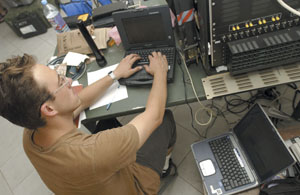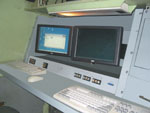National Gateway System Spreads the Word
 |
| Senior Airman John Ervin, USAF, 52nd Communications Squadron, Spangdahlem Air Base, Germany, configures a router to communicate with Croughton Royal Air Force from Dakar International Airport in Senegal. The National Gateway System improves the security of organizational messaging. |
The U.S. Defense Department’s messaging initiatives have made organizational messaging faster, easier and more secure while reducing the effort and personnel needed to perform the work.
The National Gateway System, consisting of the
The Defense Department transitioned fully in 2002 from its legacy systems to the Defense Message System (DMS). The system, which provides multimedia messaging and directory services, is operational worldwide, including in deployed locations. However, because allied countries and other
DISA’s solution, the National Gateway System, receives messages from the DMS then translates them to messages the legacy systems can accept and read, and vice versa. “The advantage [of DMS] is that it’s high-grade, organizational messaging,” says Daniel White, chief of the DMS and the
In addition to translating the messages from system to system, the National Gateway System ensures greater security of the messages. A multifunction interpreter that converts messages from one system to another performs a security check on each message. The system ensures delivery to the intended recipient and makes certain that all recipients are cleared to read the information. Messages sent through the DMS can be unclassified, classified or Top Secret. All messages, regardless of classification, are encrypted before or after the National Gateway System translates them.
“The messages are all signed and encrypted,” Michael Enea says. Enea is the program manager for Data Systems Analysts Incorporated (DSA), a contracting firm, at the
The messages handled through the system contain essential Defense Department information that can affect troop movement and maneuvers. “This is the stuff that really must get there the first time, every time,” White says.
Under the Defense Department’s previous messaging system, the Automatic Digital Network (AUTODIN), messages were sent through one of the 15 AUTODIN Switching Centers (ASCs) worldwide. Each ASC supported between 60 and 150 communications center connections at the installation or at the major command level. Messages on this system could be prepared manually on desktop terminals and released directly or couriered to the base communications center on magnetic tape, floppy disk or hard copy for release.
“The [National Gateway System] relay function is completely automated,” White says. He clarifies that unlike the AUTODIN systems, no one sits at a terminal typing a message. The DMS and the National Gateway System allow something closer to a “writer-to-reader” program, though White says that is a bit of a misnomer. “It’s really organization to organization,” he explains. One message sent on the DMS can reach hundreds of recipients and addresses within a larger organization such as a task force.
By eliminating switching centers, messages get to their intended recipients faster than through the older systems. Especially in the field, these shortened suspense times can make a big difference, White says. Deployed troops receive orders and intelligence more quickly, which was one of the benefits behind the DMS, explains Doug Wagoner, senior vice president and general manager of DSA, a contractor involved with the project.
The company has worked on Defense Department messaging systems since the 1960s. It wrote some requirements for what would eventually become the DMS and tested the program to make sure it performed as the government wanted. The firm now provides systems engineering and software life-cycle support at the
Another advantage of the DMS is that it allows senders to include attachments with their messages, a function not available through older organizational messaging methods.
 |
| The National Gateway System allows U.S. Defense Department computers using the Defense Message System to communicate with allied countries and other government departments that use legacy systems. |
The National Gateway System also requires less manpower to operate than the AUTODIN system, as switching operators are no longer required to relay every message. Only about 50 people support the mission at
The switching function of the National Gateway System is largely automatic, and the system controls the message traffic. If a connection at a particular site goes down, the
Enea asserts that the new system is improving the ability of an organization to communicate. “The system works well,” he says. “It has for some time. It’s using very current technology.”
The DMS is a commercial off-the-shelf (COTS)-based application. It runs through a modified version of Microsoft Outlook. “It provides the kind of service the users need for messaging,” says Bill Jones, vice president, command, control, communications and computers solutions for DSA.
DSA personnel say the Defense Department has the most advanced messaging system in the world, and DISA agrees. “I don’t think there’s any doubt about it,” White says.
The
“Hopefully, this will provide the path and we can get other allies onboard as they transition from their legacy systems,” White says. “It’s a major undertaking to transfer your messaging system.”
While the main function of the
The
The National Gateway System also manages the address lists for the legacy systems and the DMS. Most of the switching processes performed on the system are transparent to users. One function noticeable to legacy users is the switch from sending mail to legacy accounts to sending it to DMS accounts. The
Web Resources
Defense Message System: www.disa.mil/main/prodsol/dms.html
Defense Message System Fact Sheet: www.disa.mil/pao/fs/dms3.html
Data Systems Analysts Incorporated: www.dsainc.com




Comments